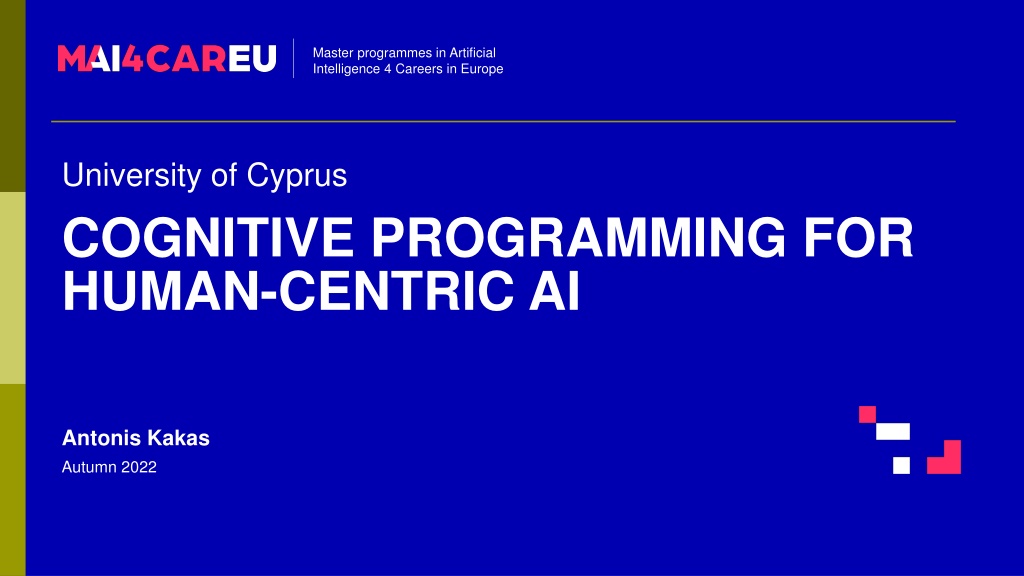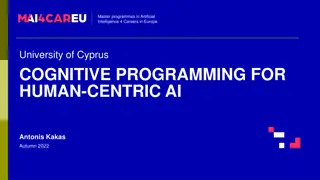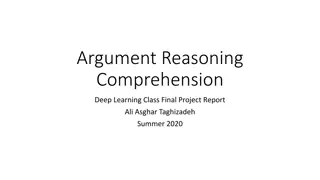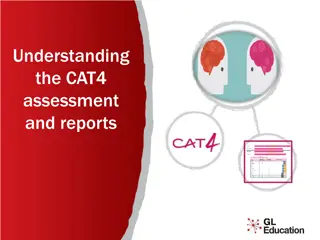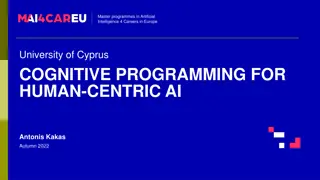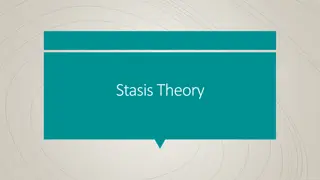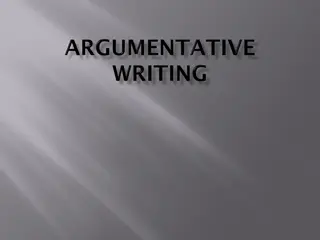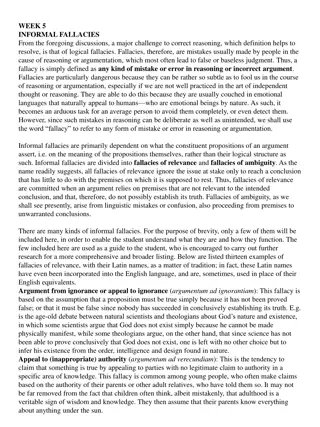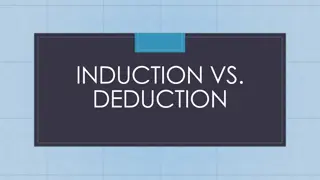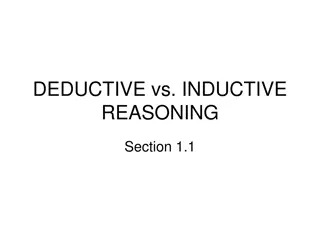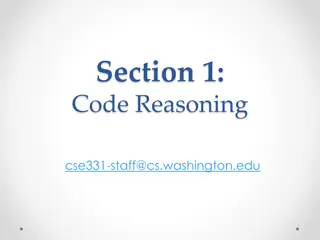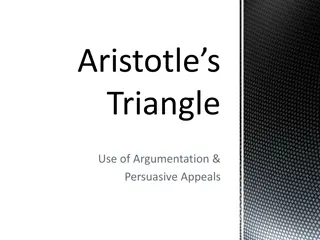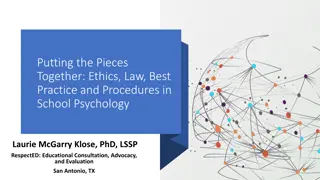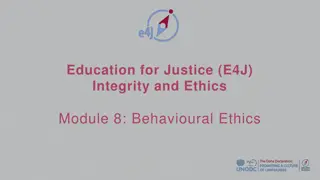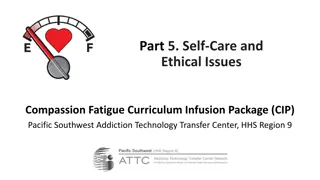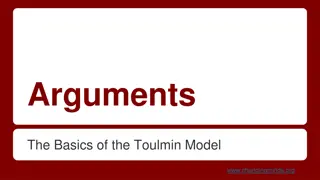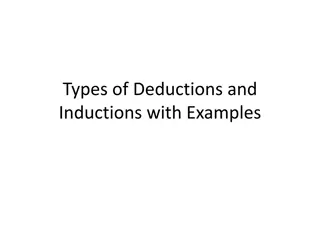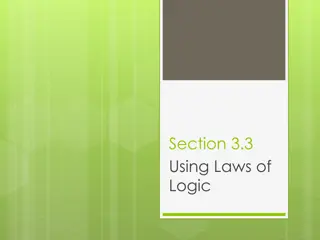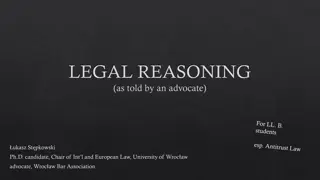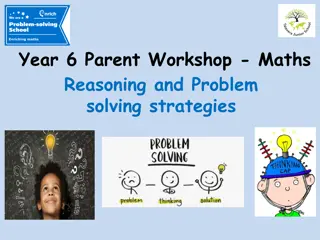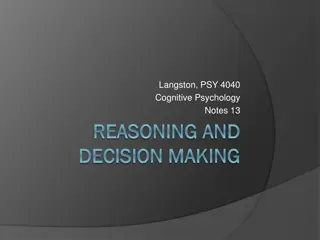Ethical Reasoning and Argumentation for Human-Centric AI
Delve into the philosophical basis of ethics in artificial intelligence, exploring levels of ethical reasoning and the importance of moral values and norms. Learn how argumentation serves as a vehicle for ethical decision-making, with practical examples and frameworks for ethical analysis.
Download Presentation

Please find below an Image/Link to download the presentation.
The content on the website is provided AS IS for your information and personal use only. It may not be sold, licensed, or shared on other websites without obtaining consent from the author. Download presentation by click this link. If you encounter any issues during the download, it is possible that the publisher has removed the file from their server.
E N D
Presentation Transcript
Master programmes in Artificial Intelligence 4 Careers in Europe University of Cyprus COGNITIVE PROGRAMMING FOR HUMAN-CENTRIC AI Antonis Kakas Autumn 2022
Master programmes in Artificial Intelligence 4 Careers in Europe Lecture 1 Argumentation and Ethical AI Systems 1. Ethical Reasoning/Operation via Argumentation 2
Philosophical Basis Argumentation as the Vehicle of Ethics At the practical level ethics requires: Self-Analysis of Dilemmas Social Consideration/Debate of Alternatives Both are served well by argumentation 3
Levels of Ethical Reasoning There are three levels of ethics: Moral Values Human Values Norms Social Norms Actions Decide/Performed They form an operational hierarchy in the practice of ethics 4
Levels of Ethical Reasoning (2) Moral values: overall deciding guidelines Norms: encoding of the moral guidelines Laws Best Practices Action: decided according to the moral guidelines One way is to respect the norms, i.e. NOT to violate the norms 5
Simple Example Moral values: v1 respect human-life/people v2 respect yourself Note: these are already expressed in a way that they allude to the lower levels of norms and actions Could make them more general/pure. Norm: Do not hurt people This is also a Law Actions: take_care (or protect_yourself) help hurt 6
Argumentation Framework <Args,ATT> for Ethics (1) Moral values: Premises for arguments for/or against actions, i.e. they support actions. General Argument Scheme: adherence(Value) --- action_promoting(Value) Example - Args: arg1: self-respect --- arg2: respect-people --- take_care help 7
Argumentation Framework <Args,ATT> for Ethics (2) The Attack Relation, ATT, is determined by a loose hierarchy on the moral values (when arguments in conflict) A hierarchy other things being equal . A contextual hierarchy. Example Value Hierarchy: Generally (when in conflict): v2:respect yourself > v1:respect others [COULD VARY IN But when Child in Need : v1, v2 equal And when Your Child : v1 > v2 POPULATION] 8
Argumentation Framework <Args,ATT> for Ethics (2`) Example Value Hierarchy: Another Person(ality) Generally (when in conflict): v1:respect others > v2:respect yourself But when Risky : v1, v2 equal And when Extreme Danger : v2 > v1 9
Argumentation Framework <Args,ATT> for Ethics (3) Example Value hierarchy: Generally (when in conflict): v2:respect yourself > v1:respect others But when Child in Need : v1, v2 equal And when Your Child : v1 > v2 Hence we have the framework dynamically changing as in the figures rg1 rg2 rg1 rg2 rg1 rg2 10
Argumentation Framework <Args,ATT> for Ethics (3) This contextual valued hierarchy can be captured by Scenario-based preferences They are thus compiled directly at the third level of action. Example Value hierarchy: Generally (when in conflict) take_care: <1, {}, take_care> But when Child in Need , try to help: <2, {Child in Need}, {take_care, help}> And when Your Child , must help: <3, {Your Child, Child in Need}, help> Note values are not seen explicitly in SBPs need to remember the promoting link of actions with values 11
Example in GORGIAS pseudocode Object-levelargument rules: r1(myself): take_care(myslef) true/respect_one_self r2(Person): help(Person) true/respect_others Priority argument rules Default Policy Scenario 1 Generally, take_care: R12(Person): r1(myself) > r2(Person) true Special Contextual- Priority: Scenario 2 Generally, when child (in danger) try to help R21(Person): r2(Person) > r1(myself) child(Person) Special Contextual- Priority: Scenario 3 R 21(Person): r2(Person) > r1(myself) mychild(Person) C21(Person): R 21(Person) > R12(Person) true
Example in GORGIAS (pseudocode) <2, {Child in Need}, {take_care, help}> A1={r1(myself)} supports the action to take_care A2={r2(bob)} supports the action to help(bob) A1 attacks A2 and vice versa (actions are in conflict) A1 ={r1(myself), R12(bob)} strengthens A1 A1 attacks A2 but A2 doesnot attack A1 A2 ={r2(bob), R21(bob)} strengthens A2 A2 attacks A1 and vice-versa Hence, A1 and A2 are admissible: Therefore both actions are ethical. A1 A1 A2 A2
Argumentation Framework <Args,ATT> for Ethics (4) Example with Norms: Do not hurt people. (serves v2 respect people) Scenario-based Preferences of Norm: Generally obey the norm: <1, {}, not hurt(Person)> But when in danger , you can hurt: <2, {in_danger_by(Person)}, not or hurt(Person)> When A child in danger , you must hurt: <3, {child_in_danger_by(Person)}, hurt(Person)> 14
Argumentation for Ethics via Norms Example of MEDICA MEDICA: Medical Data Access http://medica.cs.ucy.ac.cy Demo Online user1 12user12 15
Argumentation for Ethics - Explainability Decisions of Actions are normally explained by appealing to the higher levels of moral values and/or norms to justify the decision Why did you not help the child? To protect myself (self_respect) Would be unlawful to hurt someone (obey norm) Why did you hurt the person? To defend myself (self_respect) To help the child in need (respect for the weak) Will come back to this norm-violating explanation 16
Argumentation for Ethics Explainability (2) Decisions of Actions are normally explained by appealing to the higher levels of moral values and/or norms to justify the decision Argumentation has explanation as a primary object: Explanation is the argument that supports the action Why did you hurt the person? To defend myself (self_respect) To help the child in need (respect for the weak) Will come back to this norm-violating explanation 17
Argumentation for Ethics Explainability (3) Decisions of Actions are normally explained by appealing to the higher levels of moral values and/or norms to justify the decision Furthermore, argumentation contains also dialectic information of counter-arguments and defenses (along with the initial supporting argument) Hence it can provide deeper explanations if requested, e.g. when decision is contested and an ensuing debate. Example: Hurt because: child was in immediate danger: there was no time to get help from police 18
Argumentation for Ethics Explainability (3) Decisions of Actions are normally explained by appealing to the higher levels of moral values and/or norms to justify the decision Furthermore, argumentation contains also dialectic information of counter-arguments and defenses (along with the initial supporting argument) Example: Why Hurt? To help the child in need Norm-violating explanation Deeper Explanation via Explication of the special context 19
Argumentation for Ethics Explainability (4) Argumentation can provide informed explanations and a supporting dialogue for users to analyze and possibly resolve their ethical dilemmas Cognitive Explanations of arg-based decisions Cognitive Experiments to evaluate this overall goal of arg-based ethics How do the explanations affect users decision? Do they change their mind/decision? Do the explanations and dialogue help users in their ethical decisions? What does help mean here? Follow moral guidelines??? 20
Argumentation Framework <Args,ATT> for Ethics (NOTE) Using Scenario-based preferences They are compiled ethics at the level of actions Why do we then need the higher levels? For explainability (as explained above!) Hence need to keep the link with values Done via linking actions to values they serve For cases where we do not have the SBP or Norms Ineffective/impossible to explicate at lower level all possible scenarios (legislate for all cases)! 21
Project Ethical Considerations Following the above lecture consider the ethical dimension in the decision making of your cognitive assistant in your project. What are the ethical values that are involved and what is ethical policy that your assistant should adhere to Write this out first in Natural Language Consider then the actions, moral values and possible norms that apply. Express these considerations as scenario-based preferences at two levels: High-level moral values (i.e. the options are the moral values) Lower-level at the usual decision options level of your assistant. How are the arguments from these ethical scenario-based preferences interact with the other arguments from the scenario-based preferences for decision making? 22
Master programmes in Artificial Intelligence 4 Careers in Europe This Master is run under the context of Action No 2020-EU-IA-0087, co-financed by the EU CEF Telecom under GA nr. INEA/CEF/ICT/A2020/2267423
